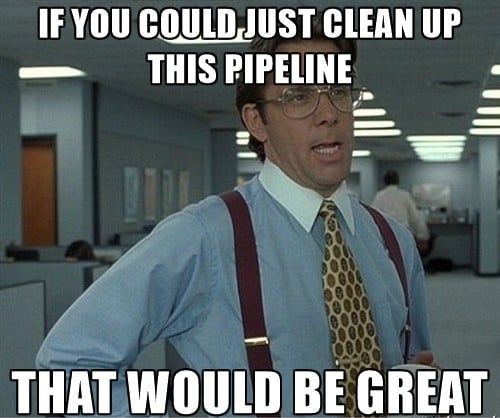Pipelines de vente 101
Les bases pour dynamiser votre processus de vente b2b.

De longues journées, des nuits tardives. Un agenda plein, un téléphone brûlant et une boîte de réception pleine à craquer. Le café est votre meilleur ami et vous travaillez sans relâche. Cela ressemble à la vie d'un entrepreneur prospère, n'est-ce pas ? Et pourtant, au milieu de cette montagne de papiers, de notes autocollantes et de courriels, vous ressentez une démangeaison. Des ventes sont réalisées, mais elles ressemblent plus à un accident qu'à un succès. This isn’t working.
I used to just let my thoughts and ideas float, not bothering with structure and organisation. To-do lists and diaries were for suckers. As a student that meant missing chapters to study. As an entrepreneur it means missing deals and revenues. And while nobody likes bad grades, missing out on sales is worse. It’s dangerous for the survival of your business. Especially if you’re in the early stages.
What you need is a system. Something to bring order to the chaos that is your sales process. Something to keep track of your leads, so no deals fall through the cracks anymore. What you need, my friend, is a sales pipeline. We’ll show you why you need one, how to set up one up and what you can do to have it run as smoothly as possible.
Why do I need this, exactly? 🤔
If you want to excel at something, you first need to get the basics right. The basics of b2b selling are pretty straightforward. Someone is looking to improve his/her life and you’re trying to help them see why your product or service is the best one for the job. C'est assez simple.
But humans are complicated creatures. Decision-making is not a linear process and external factors — like competitors — may come into play. As a sales person it’s your job to guide your prospect through the complexities that come with decision-making, straight to your solution.
A sales pipeline is a snapshot of where leads are in your sales process. It’s a visual, organised way to keep track of your potential buyers as they move through the different stages. Thinking of your sales process as a pipeline forces you to streamline your efforts into a repeatable and measurable process with clearly defined steps. It creates a shared understanding that will make your sales more actionable and scaleable.

The goal is to take your sales lead from stage to stage, all the way up to the definitive yes. If you fail, the deal is lost or can be put in the fridge to retarget later. The thing is that in sales you can’t control results. What you can control, are activities. Only when your whole team has a shared understanding of what your sales process should be, you’ll be able to optimise those activities and, in turn, improve results. In order to improve, you first need to know what your problems are.
Where is it that most deals go bad? What stage is taking the longest? How about stage-over-stage conversion? How many deals do I need to add to my pipeline to reach my goals? The sales pipeline will help you find out where you fail. Next, you’ll be able to turn those failures into best practices.
One step at a time ☝️
Chances are you’re already using the sales pipeline metaphor in approaching potential buyers. The typical stages of a sales pipeline follow the natural flow of a sales process. Of course, no sales pipeline outline fits all. Some stages may be more relevant to your sales process, others will overlap. The selling stages of your SaaS company will be different from those of a realtor. However, conceptually, a sales process goes something like this:
- Chef de file
The first time someone appears on your radar. He or she may be interested in your solution and you suspect they might be a good fit. Leads may just come to you, for example because they filled out a form on your website. Or you look for them, in places like conferences, social media or just ‘the Internet’. This is actually a prépipeline de l'étape. Vous devez d'abord déterminer s'il s'agit d'un véritable prospect pour votre entreprise avant qu'il ne devienne une opportunité de vente. - Contacté
The first time you reach out and have actual contact. This will likely happen by email or call. Your goal is to verify the lead’s interest in your solution. If yes, you put them in the pipeline. If you find a lead from a positive reaction to a cold email or call, you can immediately put the lead in this stage. - Qualification
This is where you determine whether the lead is a good fit for your business as a customer. Are they within your target market? Do they have a real need for your solution? Do they have a budget and a clear timeline to buy in? Are you talking to the right people in the company? You’ll have to determine if you think a deal can be closed within the usual length of your sales process or not. This often involves a meeting and/or a series of calls. You’ll look for a match between your solution and your lead’s specific challenges. Don’t lose any time if there’s no match: just close the sales opportunity as lost. - Proposition faite
By now, you’ve built enough momentum to make a formal offer. It’s now up to the lead to either buy or refuse. - Gagner/perdre
The moment of truth. Time to get a signature on that bottom line… or not.
A sales pipeline is like an arcade game. As a player you have to get your lead from stage to stage. You only win if you can complete all 5 stages. One mistake on the way and it’s game over for that lead. This is why it’s key to have a proper amount of leads in the front of your pipeline. You’ll want to protect yourself from certain leakage in your pipeline and make sure you win enough deals at the end of the day. This quality of the sales pipeline to actively drive your sales process is one its most important reasons for you to use it.
Great! Where do I start? 🤠
Prenez une feuille de papier ou un tas de post-it et un whiteboard. Inscrivez vos étapes de gauche à droite et attribuez une étape à chacun de vos clients potentiels actuels. Vous pouvez également ajouter d'autres données : taille de l'affaire, date de clôture prévue et commercial travaillant sur l'affaire. Ajustez ensuite votre classement au fur et à mesure que vous avancez dans le temps et que vos clients potentiels progressent dans votre pipeline. Suivez la conversion d'une étape à l'autre et le temps moyen nécessaire à chaque étape.
Aujourd'hui, pour le bien des arbres et du temps, vous voudrez peut-être troquer le stylo et le papier contre une bonne vieille feuille de calcul. C'est un excellent moyen de vous familiariser avec les principes de base de la gestion du pipeline de vente. Nous avons créé un modèle pour vous aider à démarrer. Il couvre toutes les bases de la gestion du pipeline de vente. Allez-y à fond !
Tools like Excel or Google Sheets can work fine for you as long as you’re not dealing with, let’s say, more than 10 potential customers at a time. But, as you grow bigger, the risk of losing overview and deals will do too. This is where you may want to consider using a proper CRM. Salesflare was developed to be simpler than pen and paper and more powerful than a spreadsheet.
Let’s get you a head-start 👊
So now you know what a sales pipeline is and why you need one. Time for you to get behind the wheel and start racing. Here’s three tips to make sure you make it off the start grid in pole position.
Crunch the numbers 📈
You don’t want to be driving in the dark. It’s dangerous and you have no idea where you will end up. Your pipeline’s conversion metrics are essential to keep you on the right track and will make your sales efforts scaleable.
Tout d'abord, le cycle de vente. Votre cycle de vente est le temps nécessaire pour qu'un acheteur potentiel devienne un client. En d'autres termes, combien de temps faut-il généralement à un prospect pour entrer dans votre pipeline et en ressortir ? Lorsqu'un prospect prend plus de temps que d'habitude, il est préférable de l'éliminer et de concentrer vos efforts sur d'autres prospects. Le même principe peut être appliqué aux différentes étapes.

Second, stage-over-stage conversion. Knowing how many deals you close on average will give you an idea of how many leads you need to add to meet your objectives. As said before: you can’t control results, but you can control activities.
La vente est un jeu de chiffres. Les faits, les chiffres et la science sont ce dont vous avez besoin pour maîtriser votre processus de vente. Ce n'est que lorsque tous les vendeurs suivent la même définition que vous pouvez avoir confiance dans le pipeline.
Flush regularly 🌊
Bigger isn’t always better. A pipeline stuffed with leads may seem like a good thing, but as a startup or small business you don’t have infinite resources. You’ll want to be selective in what you spend your time and energy on.

L'élimination des prospects peut sembler contre-intuitive, voire étrange. Mais c'est nécessaire pour assurer un flux régulier de prospects et de liquidités dans votre pipeline de vente. Voici quelques conseils pour garder vos tuyaux bien propres :
- Be picky when it comes to lead qualification. A clean pipeline begins with the quality of the leads you put in in the first place. If you don’t really believe a lead could turn into a sale, it doesn’t belong in your pipeline. You want to focus your efforts on deals you feel confident of closing within a healthy sales cycle.
- Do spring cleaning every one or two weeks. Check up on all the deals in your pipeline and identify the ones that hold up the pack. You don’t have to get rid of them. Instead, put them in an alternative pipeline or in the fridge, to follow up on later.
- Focus on deals you’re confident of closing within a healthy sales cycle. If you’re a Salesflare user you can use the hot-or-not feature to detect hot leads. Sluggish ones will show up in your insights and home screen.
The Power of Automation 🤖
Votre pipeline de vente a besoin d'un flux, et vous aussi. Utilisez le Le pouvoir des habitudes pour garder le contrôle de votre pipeline. L'introduction de nouvelles affaires, la qualification des prospects étape par étape et le nettoyage régulier du pipeline sont des activités clés que vous pouvez facilement intégrer dans une routine quotidienne. En transformant ces activités en habitudes, vous obtiendrez une productivité maximale avec un minimum de concentration. Votre pipeline est en pilotage automatique.

And you don’t have to stop there. Today’s technology makes it possible to run most other, mindless tasks automatically. No more admin work. Read here how Salesflare frees you of manually inputting data and automatically logs customer interactions. Zapier can make your CRM work together with all of your other productivity tools, like Google Sheets, MailChimp, Trello and Slack. You can just focus on the art of managing human relationships and closing sales while your pipeline runs itself.
Une étude 2015 de la Harvard Business Review a établi une corrélation directe entre la gestion efficace du pipeline de vente et la forte croissance du chiffre d'affaires. L'utilisation d'un pipeline de vente pour gérer votre processus de vente est le moyen le plus rapide de réaliser des prévisions, d'atteindre des quotas et de voir les commerciaux réaliser des performances au-delà de ce que vous imaginiez être possible. Il n'y a pas de prise, il suffit de le mettre en place. Vous pouvez commencer dès aujourd'hui.
Pour en savoir plus, consultez ce nouveau guide, plus long et plus détaillé, guide sur les pipelines de vente.
We hope you liked this post. If you did, hit ❤ and spread the word! You can follow us @salesflare sur Twitter pour plus d'informations sur le crm, les ventes, le growth hacking et les startups.
- The 20 Best Sales Books Elon Musk Is Probably Reading - février 14, 2023
- 6 foolproof ways to get your startup its first 100 customers - décembre 6, 2022
- Comment construire un entonnoir de vente qui se vend - 2 septembre 2021
